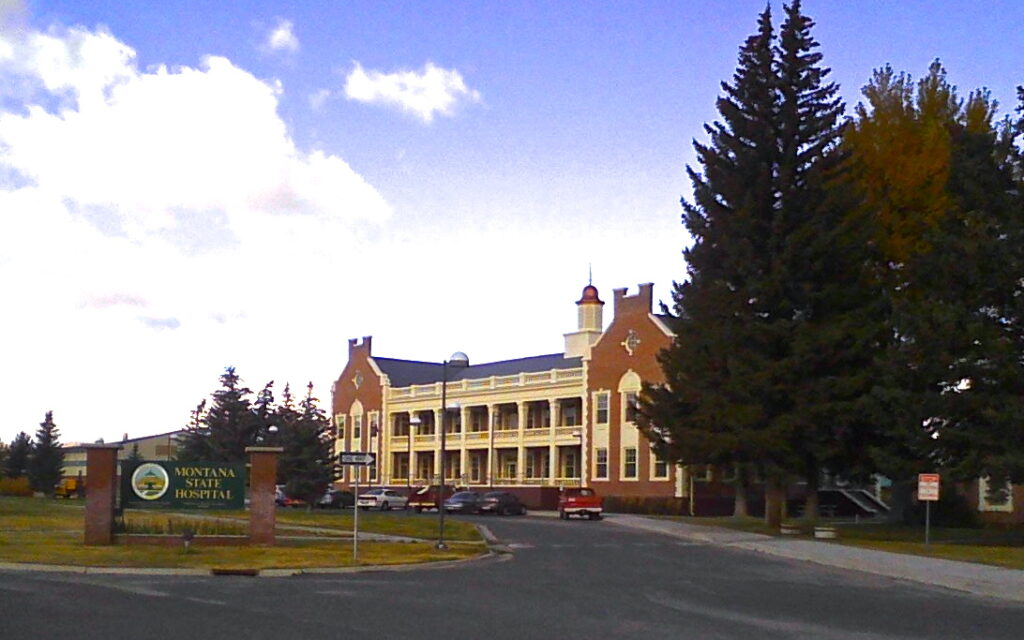
Montana State Hospital at Warm Springs (Photo via Wikimedia Commons | CC-BY-SA 3.0).
The only thing that Republican and Democratic governors seem to agree on is that no one likes the state hospital or the state forensic units, housed respectively at Warm Springs and Galen.
Both are old. Both are expensive. Both are located away from many other “populated” places in Montana. And, both seem based on something borrowed from decades earlier, rather than facilities meant to address a growing mental health and addiction problem in Montana.
For years, we’ve heard lawmakers talk about the need to get away from large institutional settings like Warm Springs and placing patients and services to places closer to patients’ homes. We like the phrase “community-based” providers instead of “state-run institutions” and it’s easy to see why.
But as we prepare for another legislative session in which lawmakers will talk about outsourcing services from places like Warm Springs or Galen, the immediate follow-up question should be: Where? Where are those community-based services?
It’s easy to see how large, out-of-state companies have come to Montana in order to allegedly help run social services. During Gov. Greg Gianforte’s first term, we’ve seen him outsource some services for unemployment and services to support childcare providers, all in the name of private business doing something more efficiently and better than the public sector, even though we haven’t seen definitive proof of either.
Lawmakers have distributed $300 million in one-time money for community-based support, but at a meeting earlier this week, four lawmakers were asked how that money was helping and none could give a clear answer if the extra funding was making any meaningful differences in Treasure State communities.
Still, there doesn’t seem to be a rush of providers or healthcare leaders running toward the Republicans’ plan of wanting to set up in-patient psychiatric centers or counseling programs. Yet, a cursory look around shows that we are continuing to expect our stretched and diminished social services agencies to do more with less.
We know that methamphetamine and fentanyl have exacerbated a public health crisis. Getting residents clean takes months, if not years, of rehabilitation.
We know that the population of Montana continues to inch upward.
And, we know that many in the Republican majority have pushed for tougher laws for criminal violations.
This has meant more pressure on jails, hospitals and mental health providers.
Meanwhile, jails continue to be filled to overflowing, many with people who have no other options, even though most people believe jail is the absolute worst place for those with mental illness or addiction. They’re not placed there because it’s the institution of last resort, it’s the institution of only resort.
Lawmakers of both parties seem open to the idea of channeling more of the marijuana revenue toward law enforcement, rehabilitation and support of jails and prison, a natural realization that one way or another, more money is needed.
However, it’s interesting that when government decides to off-load or create new programs, nearly as soon as it’s announced, companies and providers spring up to take advantage of the newly created cash stream.
But not so for mental health services in Montana.
Montana, like other states, cannot offer enough money to make the model profitable for providers or companies. In other words, there’s a reason why lawmakers and politicians year after year continue to talk about community-based providers and regional centers without seeing many, if any, materialize.
Where are they?
You won’t have to look far for the answer, or the lack thereof. Why would a private business invest millions in staff, facilities and training when counties, which are supposed to be part of the same state government infrastructure, are losing between $40 and $80 per day for every state inmate they house at jails?
And state lawmakers and the governor have the gall to lecture counties about out-of-control spending? If the state government is financially crippling the counties, then what hope does private industry have of breaking even?
Talking about an infrastructure of built-out, community programming has been discussed for years, decades even, and it’s still not here. But for years, lawmakers have been able to sacrifice and cut programs and institutions, even shuttering some, in the name of this elusive community-based model. But few can provide examples of what those models look like, how they can be replicated, or if they’re efficacious.
Meanwhile, as the state tidies up its budget, it is leaving counties in an enormous lurch, where the jails are overcrowded to the point of lawsuits, as the state pledges it’ll continue to be tough on crime without having anywhere to put these new classes of criminal.
Montana already has a network of community-based assistance organizations for vulnerable adults, they’re called nursing homes and skilled-care nursing facilities, and they exist to do exactly what lawmakers hope a network of regional mental health services would do: Take care of struggling residents close to home.
And if history is any indicator of how that’s going, many have had to close because of unsustainably low reimbursement rates and payments that lag by months.
And that, maybe more than anything, should tell Montanans why lawmakers keep on hoping, dreaming and talking about a community-based programming but despite years of talk, nothing seems to materialize.
Ironically, for a bunch of Republican lawmakers who talk so much about running the state like a business, the reason why a fully fledged system of mental health resources doesn’t exist goes back to most basic principle of running a business.
There’s literally no money in it.

